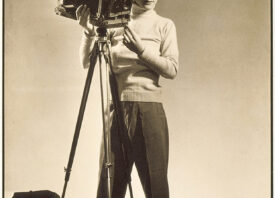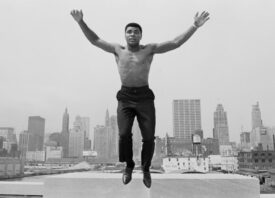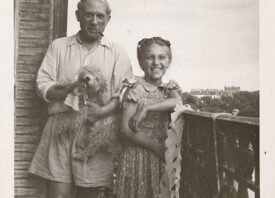Search this site
The Photograph That Rocked the Pop Culture Landscape

Peggy Moffitt modeling the topless swimsuit designed by Rudi Gernreich, 1964. Photograph © William Claxton, LLC, courtesy of Demont Photo Management & Fahey/Klein Gallery Los Angeles, with permission of the Rudi Gernreich trademark.

Rudi Gernreich (seated in center wearing black zippered jacket) among fellow artists on the steps of LACMA, 1968. Photo © Museum Associates/LACMA.
On June 16, 1964, Rudi Gernreich’s infamous monokini went on sale in New York’s most prestigious department stores. Buyers at B. Altman & Co., Lord & Taylor, Henri Bendel, Abraham & Strauss, Splendiferous and Parisette placed orders after William Claxton’s photograph of Peggy Moffit rocked the pop culture landscape.
Moffit was Gernreich’s muse and Claxton’s wife, and together this ménage a trios was pure fire. The idea for the monokini first came to Gernreich in December 1962 and first appeared in futuristic fashion feature in a late 1963 issue of Look magazine — after LIFE refused to publish them. In The Rudy Gernreich Book, Moffit recalls the editor at LIFE shamelessly told Claxton, “This is a family magazine, and naked breasts are allowed only if the woman is an aborigine.”
LIFE’s racist policy about women’s bodies cost them one of the biggest news stories of the year. They “goofed” Moffitt politely says. The magazine ordered a reshoot, demanding Moffitt cover her breasts with her arms. Moffitt described their art direction as “dirty.”
“If you are wearing a fashion that does not have a top as part of its design and hold your arms over your bosom, you’re going along with the whole prudish, teasey thing like a Playboy bunny,” Moffitt said. “The Women’s Wear Daily picture, which I think is beautiful, really shook up Madison Avenue. If the breast stops being a sex symbol — and it does the moment you uncover it — how could they tease any more in ads? How were they going to sell toothpaste?”
It’s a question the nation still struggles with today, seen in its most wicked in Les Moones’s blackballing Janet Jackson from Hollywood following the costume malfunction at the Superbowl. The bare breast is censored widely in mainstream and social media today, 55 years after Claxton’s photographs.
Just imagine what it was like in 1964 when this was brand new terrain. To call America triggered would be putting it politely — the nation was shook and the media went to work — turning this moment into fashion into a hard news story as select European nations began banning the suit from crossing the border.
The New York Times gleefully reported a quote from the Soviet government newspaper Izvestia, which haughtily remarked, “’The American way of life is on the side of everything that gives the possibility of trampling on morals and the interests of society for the sake of ego. So the decay of the moneybag society continues.”
The Saturday Evening Post noted the telling bedfellows that the opposition produced, detailing: “Such natural enemies at Izvestia, L’Osservatore Romano and the Carroll Avenue Baptist Mission of Dallas, invoking Scripture and Karl Marx, agreed that it was immoral and antisocial.”
Decadent or not, the wheel of capitalism was greased. According to The Rudy Gernreich Book, of the 3,000 women who purchased monokinis, at least two thirds wore them in public — a testament to the undeniable power of a single photograph.
In celebration, the Skirball Cultural Center in Los Angeles presents Fearless Fashion: Rudi Gernreich on view now through September 1, 2019. The exhibition showcases more than eighty ensembles including the monokini, the thong, unisex clothing, and pantsuits for women along with original sketches, letters and personal papers, photographs, press clippings, and newly filmed oral histories of friends and colleagues.
Bethany Montagno, curator, notes that Gernreich was driven to use fashion as a means to stand in his political beliefs. “After fleeing Nazi oppression as a teen, Rudi Gernreich immigrated to Los Angeles, where he encountered discrimination again,” she explains.
“He would eventually find safe haven in the performing arts world and the gay rights movement. These early experiences fueled his commitment to promoting a truer expression of self and designing clothes that proclaimed, ‘You are what you decide you want to be,’ as Gernreich himself put it.”

Peggy Moffitt modeling ensemble designed by Rudi Gernreich, Fall 1968 collection. Photograph © William Claxton, LLC, courtesy of Demont Photo Management & Fahey/Klein Gallery Los Angeles, with permission of the Rudi Gernreich trademark.

Peggy Moffitt modeling dress designed by Rudi Gernreich, Fall 1971 collection. Photograph © William Claxton, LLC, courtesy of Demont Photo Management & Fahey/Klein Gallery Los Angeles, with permission of the Rudi Gernreich trademark.

Rudi Gernreich with models wearing his designs in front of Watts Towers, c. 1965. Photograph © William Claxton, LLC, courtesy of Demont Photo Management & Fahey/Klein Gallery Los Angeles, with permission of the Rudi Gernreich trademark.

Contact sheet of Peggy Moffitt modeling a caftan designed by Rudi Gernreich, Fall 1967 collection. Photograph © William Claxton, LLC, courtesy of Demont Photo Management & Fahey/Klein Gallery Los Angeles, with permission of the Rudi Gernreich trademark. Rudi Gernreich papers (Collection 1702). Library Special Collections, Charles E. Young Research Library, UCLA.

Rudi Gernreich with Peggy Moffitt modeling the “Marlene Dietrich” pantsuit, 1964. Photograph © William Claxton, LLC, courtesy of Demont Photo Management & Fahey/Klein Gallery Los Angeles, with permission of the Rudi Gernreich trademark. Rudi Gernreich papers (Collection 1702). Library Special Collections, Charles E. Young Research Library, UCLA.

Rudi Gernreich at his office in Los Angeles, 1966. Photograph © William Claxton, LLC, courtesy of Demont Photo Management & Fahey/Klein Gallery Los Angeles, with permission of the Rudi Gernreich trademark.
All images: Courtesy of the Skirball Cultural Center in Los Angeles



